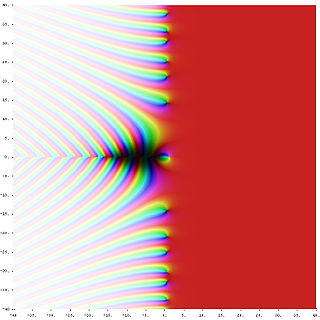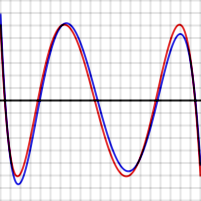This article relies largely or entirely on a single source .(June 2024) |
In mathematics, the Chebyshev integral, named after Pafnuty Chebyshev, is
where is an incomplete beta function.
This article relies largely or entirely on a single source .(June 2024) |
In mathematics, the Chebyshev integral, named after Pafnuty Chebyshev, is
where is an incomplete beta function.

In probability theory, the expected value is a generalization of the weighted average. Informally, the expected value is the arithmetic mean of the possible values a random variable can take, weighted by the probability of those outcomes. Since it is obtained through arithmetic, the expected value sometimes may not even be included in the sample data set; it is not the value you would "expect" to get in reality.

In mathematics, an integral is the continuous analog of a sum, which is used to calculate areas, volumes, and their generalizations. Integration, the process of computing an integral, is one of the two fundamental operations of calculus, the other being differentiation. Integration was initially used to solve problems in mathematics and physics, such as finding the area under a curve, or determining displacement from velocity. Usage of integration expanded to a wide variety of scientific fields thereafter.
In mathematics, the prime number theorem (PNT) describes the asymptotic distribution of the prime numbers among the positive integers. It formalizes the intuitive idea that primes become less common as they become larger by precisely quantifying the rate at which this occurs. The theorem was proved independently by Jacques Hadamard and Charles Jean de la Vallée Poussin in 1896 using ideas introduced by Bernhard Riemann.
In probability theory, Chebyshev's inequality provides an upper bound on the probability of deviation of a random variable from its mean. More specifically, the probability that a random variable deviates from its mean by more than is at most , where is any positive constant and is the standard deviation.

The Chebyshev polynomials are two sequences of polynomials related to the cosine and sine functions, notated as and . They can be defined in several equivalent ways, one of which starts with trigonometric functions:
In probability theory, Markov's inequality gives an upper bound on the probability that a non-negative random variable is greater than or equal to some positive constant. Markov's inequality is tight in the sense that for each chosen positive constant, there exists a random variable such that the inequality is in fact an equality.

In mathematics, analytic number theory is a branch of number theory that uses methods from mathematical analysis to solve problems about the integers. It is often said to have begun with Peter Gustav Lejeune Dirichlet's 1837 introduction of Dirichlet L-functions to give the first proof of Dirichlet's theorem on arithmetic progressions. It is well known for its results on prime numbers and additive number theory.

In mathematical analysis, the uniform norm assigns to real- or complex-valued bounded functions defined on a set the non-negative number

Taxicab geometry or Manhattan geometry is geometry where the familiar Euclidean distance is ignored, and the distance between two points is instead defined to be the sum of the absolute differences of their respective Cartesian coordinates, a distance function called the taxicab distance, Manhattan distance, or city block distance. The name refers to the island of Manhattan, or generically any planned city with a rectangular grid of streets, in which a taxicab can only travel along grid directions. In taxicab geometry, the distance between any two points equals the length of their shortest grid path. This different definition of distance also leads to a different definition of the length of a curve, for which a line segment between any two points has the same length as a grid path between those points rather than its Euclidean length.
In mathematics, orthogonal functions belong to a function space that is a vector space equipped with a bilinear form. When the function space has an interval as the domain, the bilinear form may be the integral of the product of functions over the interval:

In numerical analysis, Chebyshev nodes are a set of specific real algebraic numbers, used as nodes for polynomial interpolation. They are the projection of equispaced points on the unit circle onto the real interval the diameter of the circle.

In mathematics, approximation theory is concerned with how functions can best be approximated with simpler functions, and with quantitatively characterizing the errors introduced thereby. What is meant by best and simpler will depend on the application.
In mathematics, Chebyshev distance, maximum metric, or L∞ metric is a metric defined on a real coordinate space where the distance between two points is the greatest of their differences along any coordinate dimension. It is named after Pafnuty Chebyshev.
An elliptic filter is a signal processing filter with equalized ripple (equiripple) behavior in both the passband and the stopband. The amount of ripple in each band is independently adjustable, and no other filter of equal order can have a faster transition in gain between the passband and the stopband, for the given values of ripple. Alternatively, one may give up the ability to adjust independently the passband and stopband ripple, and instead design a filter which is maximally insensitive to component variations.
In commutative algebra, an element b of a commutative ring B is said to be integral over a subring A of B if b is a root of some monic polynomial over A.
In geometry, the Chebyshev center of a bounded set having non-empty interior is the center of the minimal-radius ball enclosing the entire set , or alternatively the center of largest inscribed ball of .
In mathematics, the Hahn polynomials are a family of orthogonal polynomials in the Askey scheme of hypergeometric orthogonal polynomials, introduced by Pafnuty Chebyshev in 1875 and rediscovered by Wolfgang Hahn. The Hahn class is a name for special cases of Hahn polynomials, including Hahn polynomials, Meixner polynomials, Krawtchouk polynomials, and Charlier polynomials. Sometimes the Hahn class is taken to include limiting cases of these polynomials, in which case it also includes the classical orthogonal polynomials.
In mathematics, the equioscillation theorem concerns the approximation of continuous functions using polynomials when the merit function is the maximum difference. Its discovery is attributed to Chebyshev.
In mathematics, an orthogonal polynomial sequence is a family of polynomials such that any two different polynomials in the sequence are orthogonal to each other under some inner product.
In mathematics, Zolotarev polynomials are polynomials used in approximation theory. They are sometimes used as an alternative to the Chebyshev polynomials where accuracy of approximation near the origin is of less importance. Zolotarev polynomials differ from the Chebyshev polynomials in that two of the coefficients are fixed in advance rather than allowed to take on any value. The Chebyshev polynomials of the first kind are a special case of Zolotarev polynomials. These polynomials were introduced by Russian mathematician Yegor Ivanovich Zolotarev in 1868.